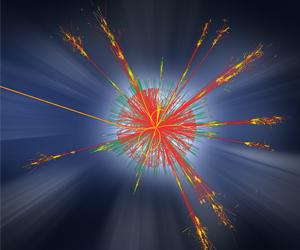Oct 9 2013
The Nobel Prize in Physics 2013 has been awarded to physicists François Englert (Université Libre de Bruxelles) and Peter W. Higgs (University of Edinburgh) “for the theoretical discovery of a mechanism that contributes to our understanding of the origin of mass of subatomic particles, and which recently was confirmed through the discovery of the predicted fundamental particle, by the ATLAS and CMS experiments at CERN's Large Hadron Collider", at the Royal Swedish Academy of Sciences in Stockholm, Sweden.

Researchers at the University of the Witwatersrand, who made significant contributions to the Higgs boson discovery in July 2012, are part of a team of researchers at the European Organization of Nuclear Research (CERN) collaborating together on the ATLAS experiment whose discovery was acknowledged and cited by the Nobel Committee when it awarded the 2013 Nobel Prize in Physics this afternoon.Read more
The Committee commented: “This is a triumph for theoretical physics and research field of elementary particle physics.” Higgs, who is went on holiday to avoid a "media storm", said in a prepared statement released by the University of Edinburgh: "I am overwhelmed to receive this award. I would also like to congratulate all those who have contributed to the discovery of this new particle and to thank my family, friends and colleagues for their support. I hope this recognition of fundamental science will help raise awareness of the value of blue-sky research."
The Wits team working on the ATLAS experiment is comprised of lead physicists Dr Oana Boeriu, Professor Bruce Mellado and Dr Trevor Vickey, as well as over two dozen staff members, postgraduate students and post-doctoral scholars (http://hep.wits.ac.za).
The team are all from the High Energy Physics Group in the School of Physics at Wits University and they are available to give insight and comment on being part of one of the biggest discoveries ever made in physics.
Dr Trevor Vickey at [email protected] or on 27 11 717 6884 or 072 966 0617
Profesoor Bruce Mellado at [email protected] or on 27 11 717 6889 or 061 303 2579
Dr Oana Boeriu at [email protected] or on 27 11 717 6885 or 072 971 6333
BACKGROUND:
The Higgs boson, an elementary particle originally theorized in 1964 and jointly discovered by the ATLAS and CMS experiments in July of last year, confirms the existence of the Higgs field and explains the origin of mass for some fundamental particles.
Tantalizing hints of a new elementary particle with a mass around 125 GeV were first reported by the ATLAS and CMS experiments in December 2011. Both experiments confirmed this excess with additional data taken in 2012 and made a joint discovery announcement in July of that same year. In March 2013, after having analysed two and a half times more data than was available for the discovery announcement, ATLAS and CMS released preliminary measurements of some properties and interactions of the new particle, strongly indicating that it is indeed a Higgs boson.
RESOURCES:
Visit the ATLAS and the Higgs boson resource page: http://www.atlas.ch/HiggsResources/